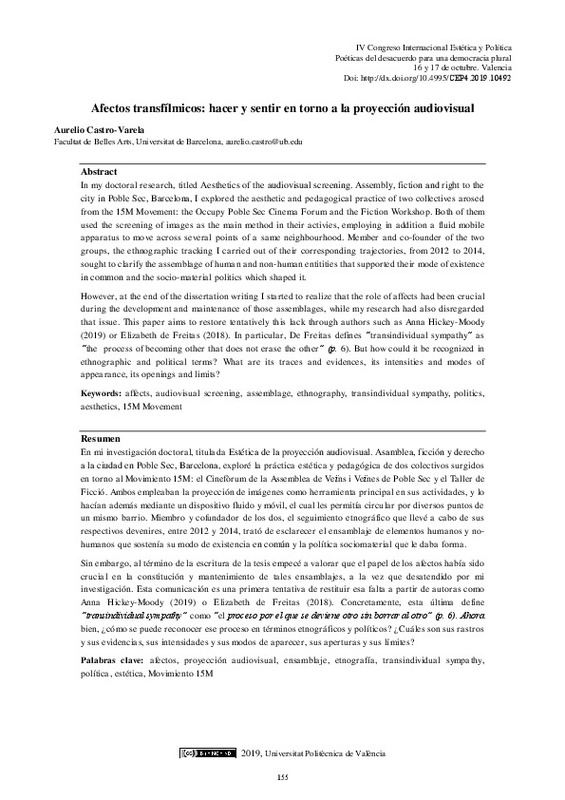JavaScript is disabled for your browser. Some features of this site may not work without it.
Buscar en RiuNet
Listar
Mi cuenta
Estadísticas
Ayuda RiuNet
Admin. UPV
Afectos transfílmicos: hacer y sentir en torno a la proyección audiovisual
Mostrar el registro sencillo del ítem
Ficheros en el ítem
| dc.contributor.author | Castro-Varela, Aurelio
|
es_ES |
| dc.date.accessioned | 2019-11-26T11:07:27Z | |
| dc.date.available | 2019-11-26T11:07:27Z | |
| dc.date.issued | 2019-10-30 | |
| dc.identifier.isbn | 9788490488027 | |
| dc.identifier.uri | http://hdl.handle.net/10251/131804 | |
| dc.description.abstract | [ES] En mi investigación doctoral, titulada Estética de la proyección audiovisual. Asamblea, ficción y derecho a la ciudad en Poble Sec, Barcelona, exploré la práctica estética y pedagógica de dos colectivos surgidos tras el Movimiento 15M: el Cinefòrum de la Assemblea de Veïns i Veïnes de Poble Sec y el Taller de Ficció. Los dos empleaban la proyección de imágenes como principal herramienta de sus actividades, y lo hacían además mediante un dispositivo fluido y móvil que les permitía circular por diversos puntos de un mismo barrio. Miembro activo en ambos casos de estudio, el seguimiento etnográfico que llevé a cabo de sus respectivos devenires trataba de esclarecer un modo de existencia en común a través del “agenciamiento” (Deleuze y Guattari, 1988) de elementos humanos y no-humanos que lo sostenía y de la política sociomaterial que le daba forma. Sin embargo, al término de la escritura de la tesis empecé a valorar que el papel de los afectos había sido crucial en la constitución y desarrollo de tales agenciamientos, a la vez que desatendido en cierta medida por mi investigación. Esta presentación busca restituir esa falta a partir de autoras como Anna Hickey-Moody (2019), Lauren Berlant (2012) o Elizabeth de Freitas (2018). Concretamente, esta última ha calificado como “transindividual sympathy” al “proceso por el que se deviene otro sin borrar al otro” (p. 6). Se trata del ensamblaje afectivo de una serie de personas y cosas cuyas capacidades para obrar o modificar una situación resultan, y se mantienen, heterogéneas. O, en definitiva, de un hacer y sentir conjunto (es decir, alentado por otros y junto a otros). Ahora bien, ¿cómo se puede reconocer ese proceso en términos etnográficos y políticos? ¿Cuáles son sus rastros y sus evidencias, sus intensidades y sus modos de aparecer, sus aperturas y sus límites? | es_ES |
| dc.description.abstract | [EN] In my doctoral research, titled Aesthetics of the audiovisual screening. Assembly, fiction and right to the city in Poble Sec, Barcelona, I explored the aesthetic and pedagogical practice of two collectives arosed from the 15M Movement: the Occupy Poble Sec Cinema Forum and the Fiction Workshop. Both of them used the screening of images as the main method in their activies, employing in addition a fluid mobile apparatus to move across several points of a same neighbourhood. Member and co-founder of the two groups, the ethnographic tracking I carried out of their corresponding trajectories, from 2012 to 2014, sought to clarify the assemblage of human and non-human entitities that supported their mode of existence in common and the socio-material politics which shaped it. However, at the end of the dissertation writing I started to realize that the role of affects had been crucial during the development and maintenance of those assemblages, while my research had also disregarded that issue. This paper aims to restore tentatively this lack through authors such as Anna Hickey-Moody (2019) or Elizabeth de Freitas (2018). In particular, De Freitas defines “transindividual sympathy” as “the process of becoming other that does not erase the other” (p. 6). But how could it be recognized in ethnographic and political terms? What are its traces and evidences, its intensities and modes of appearance, its openings and limits? | es_ES |
| dc.format.extent | 6 | es_ES |
| dc.language | Español | es_ES |
| dc.publisher | Editorial Universitat Politècnica de València | es_ES |
| dc.relation.ispartof | IV Congreso Internacional Estética y Política: Poéticas del desacuerdo para una democracia plural | |
| dc.rights | Reconocimiento - No comercial - Sin obra derivada (by-nc-nd) | es_ES |
| dc.subject | Educación | es_ES |
| dc.subject | Democracia radical | es_ES |
| dc.subject | Prácticas artísticas | es_ES |
| dc.subject | Estética | es_ES |
| dc.subject | Política | es_ES |
| dc.title | Afectos transfílmicos: hacer y sentir en torno a la proyección audiovisual | es_ES |
| dc.type | Capítulo de libro | es_ES |
| dc.type | Comunicación en congreso | es_ES |
| dc.identifier.doi | 10.4995/CEP4.2019.10492 | |
| dc.rights.accessRights | Abierto | es_ES |
| dc.description.bibliographicCitation | Castro-Varela, A. (2019). Afectos transfílmicos: hacer y sentir en torno a la proyección audiovisual. En IV Congreso Internacional Estética y Política: Poéticas del desacuerdo para una democracia plural. Editorial Universitat Politècnica de València. 155-160. https://doi.org/10.4995/CEP4.2019.10492 | es_ES |
| dc.description.accrualMethod | OCS | es_ES |
| dc.relation.conferencename | IV Congreso Internacional Estética y Política: Poéticas del desacuerdo para una democracia plural | es_ES |
| dc.relation.conferencedate | Octubre 16-17,2019 | es_ES |
| dc.relation.conferenceplace | Valencia, Spain | es_ES |
| dc.relation.publisherversion | http://ocs.editorial.upv.es/index.php/CEP/CEP4/paper/view/10492 | es_ES |
| dc.description.upvformatpinicio | 155 | es_ES |
| dc.description.upvformatpfin | 160 | es_ES |
| dc.type.version | info:eu-repo/semantics/publishedVersion | es_ES |
| dc.relation.pasarela | OCS\10492 | es_ES |








